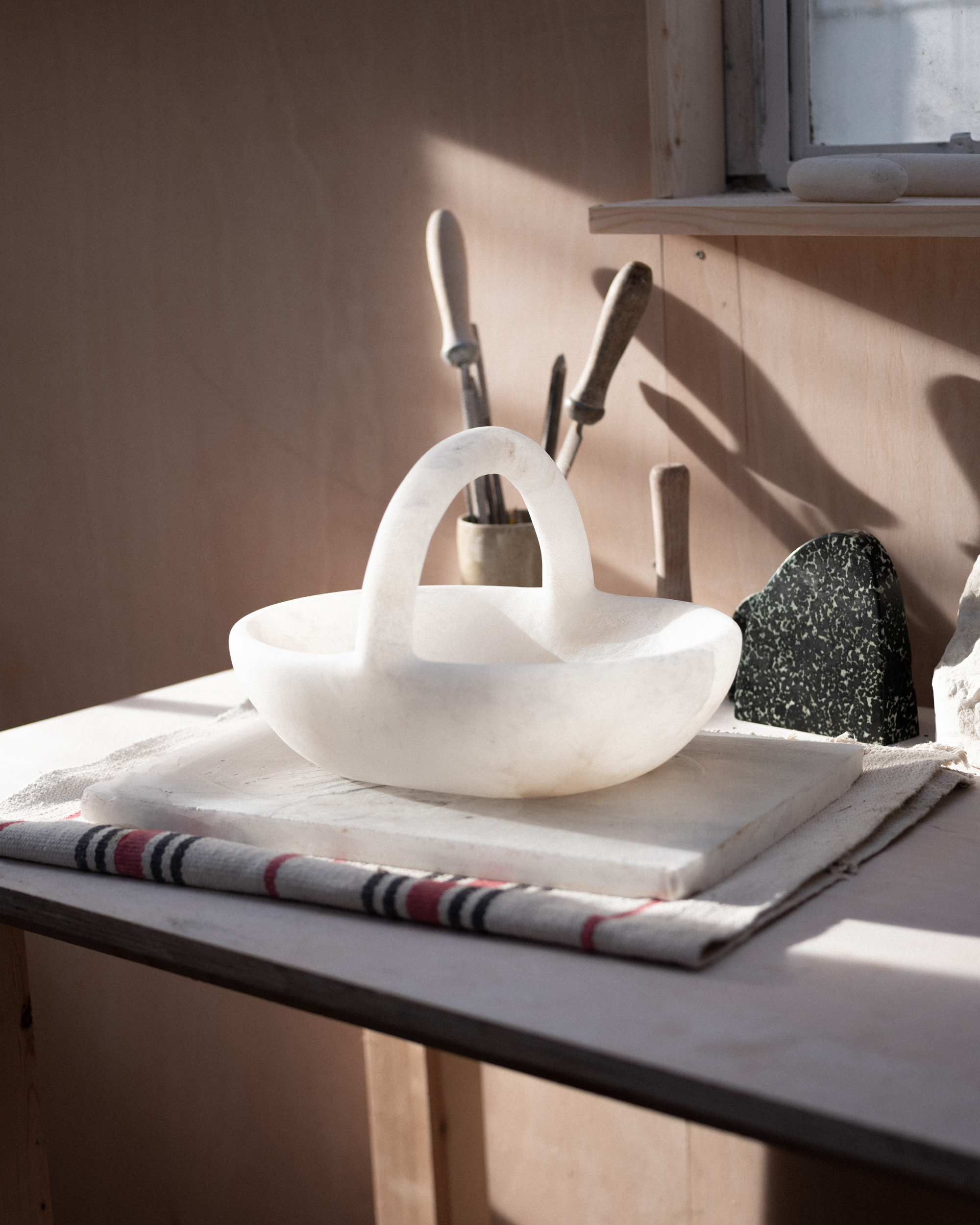
Q&A with QEST Scholar Oliver Cook
Winch Design is delighted to announce our latest QEST scholar - Oliver Cook. Oliver Cook is a sculptor creating sculptural objects and vessels in alabaster. His self-taught technique and process have developed organically following traditional carving techniques. His works are both functional and sculptural, exploring the relationship between the translucent properties of the stone and light. His scholarship with QEST, funded by Winch Design will allow Oliver to participate in three different marble workshops over the course of 18 months with the marble workshop in Pietrasanta, Italy. This month we caught up with him for an insightful Q&A session.

How did you discover stone carving?
I discovered stone carving through the works of Hanna Echel and Isamu Noguchi, I’d seen stone sculptures before by artists like Barbara Hepworth and Henry Moore but saw stone in a new light again and it really resonated with me so I delved into their works online and started to look for workshops that I could join. In the end I decided to buy a block of stone and just have a go as I already had some simple tools. The yard I bought the stone from was based in Yelvertoft (now sadly closed) so I drove over to have a look. They stocked a wide variety of stones; marble (in many different colours), soapstone, limestone and alabaster. I found it really difficult to make my mind up about what to buy and I was walking around looking at all these different boulders and sawn blocks.
I spoke to the owner for quite a long time learning about the different properties of each of the different stones, the industry and history of his stoneyard which was really fascinating. In the end I bought two blocks, one white translucent and one rainbow. I had no intention of buying translucent alabaster, but I really liked how even in large square cut blocks you could see the translucent properties.


What were you doing before you started stone carving?
Before I began stone carving, I dedicated a lot of my time to working with wood, crafting small pieces of furniture, and carving spoons and other items. My creative pursuits also extended to ceramics and metal casting, including working with bronze and iron. These creative endeavours have always been a passion of mine but were pursued alongside my main job during my spare time.
How long did it take to teach yourself to carve in stone?
I’m still learning! It’s been a very organic learning process having spent so much time making things for much of my life, transitioning from using wood to stone chisels and metal / wood rasps to diamond files has felt quite natural. That being said the activities I’m undertaking through the QEST scholarship are teaching me the correct techniques of working with stone and I’ll be using completely new tools such as airhammers which will help me take on bigger, more complex pieces in harder materials like marble and limestone.
What is your motivation for working with stone?
I love the tactility of stone, especially in a world dominated by synthetic materials - plastic surfaces, chipboard mimicking wood, or ceramic tiles with artificial marble patterns. There's something deeply inspiring about working with a material so pure and it drives me to do it justice by unveiling its natural beauty.
Where do you seek inspiration from for your pieces?
Natural light is always a big inspiration, the thickness of the material directly affects the amount of light that can pass through allowing you to see more of the veining within the stone. As my skills have developed the thickness of the walls in vases has got thinner and thinner letting even more light through.
Visiting museums is also a huge source of inspiration, seeking out the ancient vases and vessels on display, I find it amazing that there were people thousands of years ago carving vases from alabaster in similar forms which I think is a testament to the timelessness of the material.
What do you aim to achieve with your pieces?
I want to achieve something that offers the viewer a slightly different moment each time they see one of my pieces. The translucent property of the stone means it reflects the environment in which it’s placed. If it’s in a window, the pastel morning light, or the warm colours during sunset, will be subtly refracted within the stone. I want to make pieces that invite a dialogue between the environments they’re placed in.
What does becoming a QEST scholar mean to you?
It really means a lot, it’s a validation of sorts after always feeling imposter syndrome around being called an artist and sculptor. When I first started sharing my work online, I was very fortunate to have interest in my work from galleries relatively quickly and had my first solo show within a year of first posting work so becoming a QEST scholar and giving myself time to learn about the craft of stone sculpture and as well as the business side of being an artist is invaluable.
This year has been especially important for me as I applied in February just after I’d recently been made redundant from the job I’d been doing on the side since when I first began. So I want to use all the skills I learn via the training and Cockpit professional development to help me make the transition to working with stone full-time.


To see more of Oliver Cook’s work visit his website here - Oliver Cook